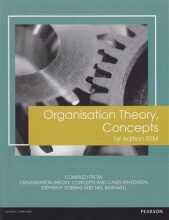Summary: 978-1-78447-945-9 | 9781784479459 | Stephen P Robbins, et al
- This + 400k other summaries
- A unique study and practice tool
- Never study anything twice again
- Get the grades you hope for
- 100% sure, 100% understanding
Read the summary and the most important questions on 978-1-78447-945-9 | 9781784479459 | Stephen P. Robbins, Neil Barnwell
-
1 An Overview
This is a preview. There are 6 more flashcards available for chapter 1
Show more cards here -
What are the four components of the definition of an organisation?
Consciously managed – management hierarchy involved in decision making
Identifiableboundary – definable boundary must exist to distinguish members from non-members
Continuing bond – which is not a lifelong membership but commitment for a certain timeframe
Common goal – organisations must exist to achieve something, what they set out to achieve is set in the organisations goal. -
What is organisation structure?
Organisation structure defines:
1 How tasks are to be allocated;
2 Areas of responsibility and authority;
3 Reporting relations;
4 Formal coordinating mechanisms and interaction patterns that will be followed.
Organisation structure consists of three components:
1 Complexity;
2 Formalisation;
3 Centralisation. -
What is complexity and what are the three components of it?
Complexity considers the extent of differentiation within the organisation. This includes the degree of specialisation (or division of labour).
1 Horizontal differentiation
2 Vertical differentiation
3 Spatial Dispersion -
What is the difference between organisation theory and organisational behaviour?
Although there is an overlap between the two:
Organisational behaviour focusses on the bahaviour within organisations -individual and group behaviour- and on a narrow set of employee performance and attitude variables. Micro-perspective
Organisation theory focusses on macro-perspective. For example it studies how organisation structure influences employee behaviour. -
What are the two metaphors used to compare organisations?
1 The system perspective
2The life cycle perspective -
When using the system perspective, what types or systems exist?
1 The closed system, where there are no environmental interactions
2 The open system, where there are environmental interactions -
State and describe the eight characteristics of an open system
1 Environmental awareness - concistent interaction with environment
2 Feedback - adjusts to information from environment
3 Cyclical character - cycle of events
4 Tendency towards growth - able to import energy from environment
5 Steady state - external imput balances output winding-down properties
6 Movement towards growth and expansion - grow and expand to create surplus for survival
7 Balance of maintenance and adaptive activities - need to maintain a status quo but be able to adapt to environment
8 Equifinality - multiple paths exist to achieve the same goal -
How can the systems perspective help you better understand organisations?
- To view the organisation as interdependent subsystems which need to be integrated to for a complete and effective system;
- Prevents or deters lower level manager from viewing their jobs as managing static, isolated elements;
-Encourages managers to identify and understand the changing nature of the environment in which their system operates and the way it nurtures and threatens the organisation;
- Helps to see stable patterns and actions within boundaries;
- Helps to gain insight into why organisations are resistant to change;
- Directs attention to alternative inputs and processes got reaching goals. -
What are the problems with the systems perspective?
- Abstract concept – observer sees complex interactions of systems, subsystems and environments. Tendency to consider that everything depends on everything else. This makes it difficult to isolate specific problems and to offer to management suggestions about changes and the degree of changes.
- Poor explanatory power why and how organisations change over time. The answer to this is the life-cycle perspective. -
What is the importance of the life-cycle perspective?
Let us view organisations as dynamic entities
The life-cycle perspective suggests that different problems occur in different stages of the life-cycle and that they cant be dealth with accordingly.
This makes them predictable.
- Higher grades + faster learning
- Never study anything twice
- 100% sure, 100% understanding
































